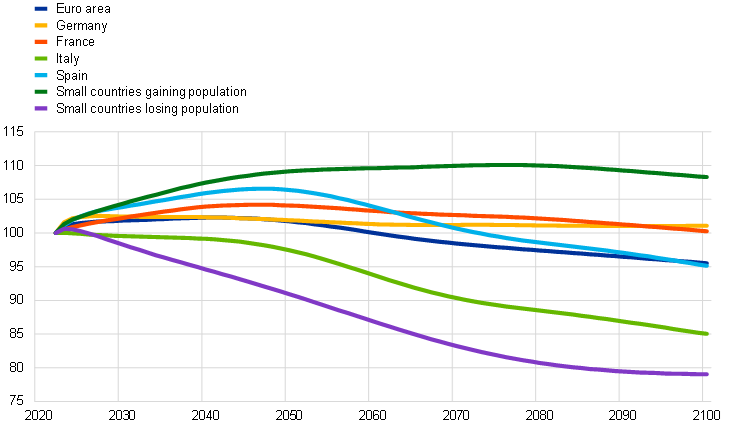
The Recent Demographic Outlook for the Euro Area
Published as part of the ECB Economic Bulletin, Issue 3/2023.
Introduction
The recent coronavirus (COVID-19) pandemic and the influx of migrants are leaving a mark on the demographic outlook for the euro area, with implications for the long-term economic outlook. This report reviews the demographic trends derived from the latest EUROPOP2023 population projections, which were published by Eurostat on 30 March 2023. These projections cover the size and structure of the population of all EU Member States for the period 2022-2100. Revisions in the demographic projections are driven by recent changes in birth rates, mortality rates and migration flows. In view of the long-term horizon, the projections are surrounded by a high degree of uncertainty. This report focuses on revisions compared with the previous update of the population projections, which were released in 2019, and their impact on economic growth prospects and fiscal sustainability in the euro area.[1]
Population Trends
In line with previously expected long-term trends, the euro area’s population is projected to continue ageing and to shrink significantly over the coming generations. According to Eurostat’s updated projections, the euro area population is expected to decrease by 4.5% between 2022 and 2100, equivalent to 16 million fewer people, with the decline particularly pronounced in some countries (Chart A). Owing to the ageing population, the fall in the euro area’s working-age population (persons aged between 15 and 64) will be more severe than that of the overall population. The number of people of working age is expected to drop by 19%, from 221 million in 2022 to 180 million in 2100. This will lead to a rapid increase in the old-age dependency ratio, from 34% in 2022 to around 51% in 2050 and 60% in 2100 – that is, from one elderly person for every three working-age people in 2022 to just under two elderly people in 2100.
Chart A
Demographic projections for the euro area
(index 100 = population in 2022)

Source: Authors’ own calculations based on Eurostat data.
Notes: Demographic outlook based on EUROPOP2023 demographic projections. Total population corresponds to the population on 1 January of each year, as reported in the Eurostat annual demographic statistics data collection. “Small countries gaining population” refers to the population-weighted average of Belgium, Ireland, Cyprus, Luxembourg, Malta, the Netherlands and Austria (these countries’ populations are expected to grow between 2022 and 2100). “Small countries losing population” refers to the population-weighted average of Estonia, Greece, Croatia, Latvia, Lithuania, Portugal, Slovenia, Slovakia and Finland (these countries’ populations are expected to shrink between 2022 and 2100).
Impact of the Pandemic and Migration
The pandemic and the influx of migrants have affected the demographic outlook for the euro area relative to the 2019 population projections in different ways, with a positive net impact. The euro area population, including Croatia, is projected to rise from 347 million in 2022 to a peak of 355 million in 2041 – four years later than previously projected. The euro area population is now expected to be 0.7% larger in 2025 and 1.4% larger at the 2050 horizon than previously projected. The bulk of revisions in demographic trends is accounted for by much stronger net immigration, from Ukraine and other countries (Chart B). Net migration is projected to normalise by 2025 but remain slightly above the level of the EUROPOP2019 estimates throughout the projection horizon.[2] As most migrants are of working age, this tends to ease demographic pressures on labour supply and public finances. At the same time, the pandemic has significantly increased the mortality rate in euro area countries, particularly among the elderly.[3] These developments outweigh the adverse effect of the pandemic on fertility rates in most countries.[4] Taking into account all the different recent developments, the old-age dependency ratio is projected to improve by 0.6 percentage points by 2025 and 1.4 percentage points (to 51%) by 2050 relative to the 2019 projections. Some euro area countries have benefited more from these recent demographic developments than others (Chart C).[
SDGs, Targets, and Indicators
1. Which SDGs are addressed or connected to the issues highlighted in the article?
- SDG 3: Good Health and Well-being
- SDG 4: Quality Education
- SDG 8: Decent Work and Economic Growth
- SDG 10: Reduced Inequalities
- SDG 11: Sustainable Cities and Communities
- SDG 16: Peace, Justice, and Strong Institutions
- SDG 17: Partnerships for the Goals
The article discusses the demographic outlook for the euro area, including the impact of the COVID-19 pandemic and migration on population trends. These issues are connected to several SDGs, including SDG 3 (health), SDG 4 (education), SDG 8 (economic growth), SDG 10 (inequalities), SDG 11 (sustainable cities), SDG 16 (justice), and SDG 17 (partnerships).
2. What specific targets under those SDGs can be identified based on the article’s content?
- SDG 3.8: Achieve universal health coverage, including financial risk protection, access to quality essential health-care services, and access to safe, effective, quality, and affordable essential medicines and vaccines.
- SDG 4.1: By 2030, ensure that all girls and boys complete free, equitable, and quality primary and secondary education leading to relevant and effective learning outcomes.
- SDG 8.5: By 2030, achieve full and productive employment and decent work for all women and men, including for young people and persons with disabilities, and equal pay for work of equal value.
- SDG 10.2: By 2030, empower and promote the social, economic, and political inclusion of all, irrespective of age, sex, disability, race, ethnicity, origin, religion, or economic or other status.
- SDG 11.3: By 2030, enhance inclusive and sustainable urbanization and capacity for participatory, integrated, and sustainable human settlement planning and management in all countries.
- SDG 16.6: Develop effective, accountable, and transparent institutions at all levels.
- SDG 17.17: Encourage and promote effective public, public-private, and civil society partnerships, building on the experience and resourcing strategies of partnerships.
Based on the article’s content, the identified targets are related to achieving universal health coverage (SDG 3.8), ensuring quality education (SDG 4.1), promoting decent work (SDG 8.5), reducing inequalities (SDG 10.2), sustainable urbanization (SDG 11.3), strengthening institutions (SDG 16.6), and fostering partnerships (SDG 17.17).
3. Are there any indicators mentioned or implied in the article that can be used to measure progress towards the identified targets?
- Indicator for SDG 3.8: Access to quality essential health-care services and essential medicines.
- Indicator for SDG 4.1: Completion rates of primary and secondary education.
- Indicator for SDG 8.5: Employment rates and equal pay for work of equal value.
- Indicator for SDG 10.2: Social, economic, and political inclusion of all individuals.
- Indicator for SDG 11.3: Sustainable urbanization and participatory human settlement planning.
- Indicator for SDG 16.6: Effectiveness, accountability, and transparency of institutions.
- Indicator for SDG 17.17: Public-private and civil society partnerships.
The article mentions or implies indicators such as access to quality healthcare services, completion rates of education, employment rates, equal pay, social inclusion, sustainable urbanization, institutional effectiveness, and partnerships. These indicators can be used to measure progress towards the identified targets.
Table: SDGs, Targets, and Indicators
| SDGs | Targets | Indicators |
|---|---|---|
| SDG 3: Good Health and Well-being | 3.8: Achieve universal health coverage, including financial risk protection, access to quality essential health-care services, and access to safe, effective, quality, and affordable essential medicines and vaccines. | Access to quality essential health-care services and essential medicines. |
| SDG 4: Quality Education | 4.1: By 2030, ensure that all girls and boys complete free, equitable, and quality primary and secondary education leading to relevant and effective learning outcomes. | Completion rates of primary and secondary education. |
| SDG 8: Decent Work and Economic Growth | 8.5: By 2030, achieve full and productive employment and decent work for all women and men, including for young people and persons with disabilities, and equal pay for work of equal value. | Employment rates and equal pay for work of equal value. |
| SDG 10: Reduced Inequalities | 10.2: By 2030, empower and promote the social, economic, and political inclusion of all, irrespective of age, sex, disability, race, ethnicity, origin, religion, or economic or other status. | Social, economic, and political inclusion of all individuals. |
| SDG 11: Sustainable Cities and Communities | 11.3: By 2030, enhance inclusive and sustainable urbanization and capacity for participatory, integrated, and sustainable human settlement planning and management in all countries. | Sustainable urbanization and participatory human settlement planning. |
| SDG 16: Peace, Justice, and Strong Institutions | 16.6: Develop effective, accountable, and transparent institutions at all levels. | Effectiveness, accountability, and transparency of institutions. |
| SDG 17:
Behold! This splendid article springs forth from the wellspring of knowledge, shaped by a wondrous proprietary AI technology that delved into a vast ocean of data, illuminating the path towards the Sustainable Development Goals. Remember that all rights are reserved by SDG Investors LLC, empowering us to champion progress together. Source: ecb.europa.eu
Join us, as fellow seekers of change, on a transformative journey at https://sdgtalks.ai/welcome, where you can become a member and actively contribute to shaping a brighter future.
|







